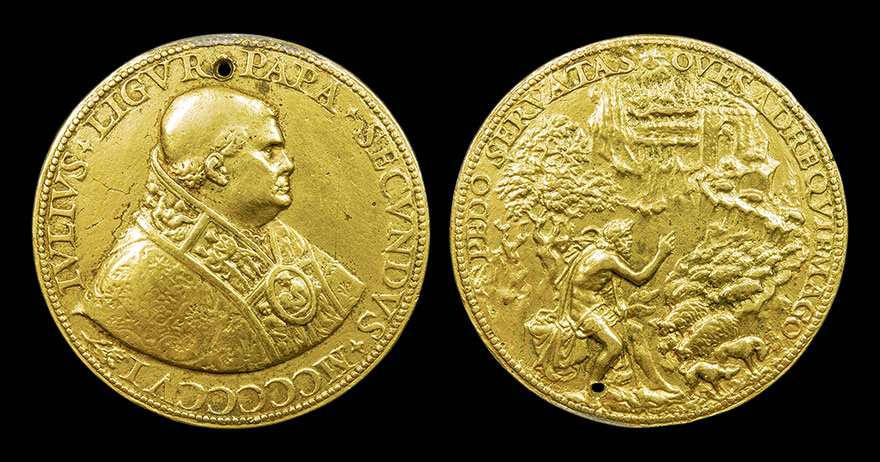World Medals: A World of Fun
 Stella
Posts: 725 ✭✭✭✭✭
Stella
Posts: 725 ✭✭✭✭✭
Do you collect world medals? Let's see what you have to share.
I will start with a NEWP, a 1913 Swiss medal from the Langnau Exhibition. I couldn't resist the interesting combination of chickens, a proud peacock, and a rabbit all included on the obverse. While not an expensive piece, I had not seen one of these before and am pleased to have added it to the "flock."

Coin collector since childhood and New York Numismatist at Heritage Auctions.
4
Comments
I like it congratulations 😊
I give away money. I collect money.
I don’t love money . I do love the Lord God.
How does one get a hater to stop hating?
I can be reached at evillageprowler@gmail.com
Thank you, @bidask !
Those are nice, @EVillageProwler .
John VIII Palaeologus by Pisanello, c. 1438-39

Isotta degli Atti by Matteo de' Pasti, c. 1453/1455

Ludovico Maria Sforza by Cristoforo Foppa Caradosso, c. 1488

Pope Julius II by Cristoforo Foppa Caradosso, 1506

Gianello della Torre by Jacopo Nizzola da Trezzo, 1548

Pope Alexander VII by Gioacchino Francesco Travani, 1659

Cosimo Serristori by Massimiliano Soldani-Benzi, 1711

Antoine Ruzé by Jean Warin, 1629

Charles de Solier by Christoph Weiditz, c. 1530-31

Joost van den Vondel, possibly by Jan Lutma the Younger, dated 1679

I have a few more such medals on my website:
https://www.virtuscollection.com/
Virtus Collection - Renaissance and Baroque Medals
Thanks @Stella.
BTW, @Iosephus has great medals. (Others too.)
How does one get a hater to stop hating?
I can be reached at evillageprowler@gmail.com
IMO, the nicest of A. Machin portraits
Well, just Love coins, period.
Not a collector of them, but have a few lying around. Sorry, not the best picture sometimes.
Medals can take advantage of very high relief.

Pacific Northwest Numismatic Association
A fascinating memento from Scottish and British history, this AR medal by Nicholas Briot was struck in 1633 to commemorate Charles I's very belated Scottish coronation that year. His coronation should have been much earlier, he ascended the throne in 1625, but he carelessly delayed said coronation until finally giving into demands that it be done in 1633. His introduction of Anglican liturgy into the coronation ceremony did little to endear him to his Scottish subjects, and things went decidedly sour thereafter. On his return trip to London his baggage including many crown jewels were lost in the Firth of Forth, just off of Burntisland. Subsequently alleged witches were brought to trial in London, on charges of causing the shipwreck. Things went down for Charles I from there on, both in Scotland and in England.
This lovely medal, with a lifelike portrait of the monarch, was commissioned to Nicholas Briot, a famous and skilled coiner. This medal was struck in a screw press, and is actually much better detailed as a result. One of these medals was struck piedfort in gold, which was presented to the King, he kept it as a pocket piece until his death in 1649. The silver examples like this one were thrown by the king to the crowds at the coronation ceremony.
A few of my favorite world medals by Lucien Bazor:
The message on this interesting medal, as I understand it, is a satire of politicians and the corrupt practice "you scratch my back and I'll scratch yours":



Yeah! Your pictures are now showing without having to click on a link! Perhaps you can educate others?
I mostly sell a variety of medals, and have a particular focus upon skulls and skeletons in medallic art. I've had a number of the Blumenbach "3 Skulls" type pass through my inventory, but after purchasing this one, I knew that I had to keep it. It's by far the most attractive and lustrous example of the type that I have ever encountered.
For the backstory on the medal, it was issued in 1825 in order to commemorate the 50th anniversary of the doctorate of a famous anthropologist, Johann Friedrich Blumenbach. Even into the early 20th century, it was popular among more well-to-do circles to commission the striking of a medal in order to commemorate a special event for another, which is why there exist medals like this commemorating seemingly random events of private individuals.
Specifically, Blumenbach studied skulls from around the world—a study that would come to be known as craniomety. According to his classification, the three skulls represented on this medal's reverse were meant to viewed as "Caucasian, Ethiopian, and Mongolian."
Jeremy Bostwick
For exceptional works of medallic art, check out our current inventory at Numismagram!